Popular type robot design collection
Robots have been around for decades, and the definition of robots is still benevolent, wise see wisdom, and there is no unified opinion. One of the reasons is that robots are still developing, new models, and new features are constantly emerging. Perhaps it is because of the ambiguity of the definition of robots that it gives people full imagination and space for creation.
As you can see in various popular science books, robots are divided into the following types:
Housekeeping robots: help people manage their lives and do simple housework.
Operational robot: automatic control, reprogrammable, multi-functional, with several degrees of freedom, can be fixed or moved for use in related automation systems.
Program-controlled robot: The mechanical motion of the robot is controlled in turn according to the order and conditions required in advance.
Teaching Reproduction Robot: By guiding or otherwise, the robot is taught first, and the working program is input, and the robot automatically repeats the work.
CNC-type robot: The robot is taught by numerical values, language, etc., and the robot performs work based on the information after teaching.
Sensory Control Robot: Controls the motion of the robot using information acquired by the sensor.
Adaptive Control Robot: Can adapt to changes in the environment and control its own actions.
Learning Control Robots: Experiences that “experience†work, have a certain learning function, and apply the “learning†experience to work.
Intelligent robot: A robot that uses artificial intelligence to determine its actions.
From the application environment, our robotics experts divide robots into two categories, namely industrial robots and special robots.
The so-called industrial robot is a multi-joint robot or a multi-degree-of-freedom robot for the industrial field.
Special robots are various advanced robots other than industrial robots for non-manufacturing and serving humans, including: service robots, underwater robots, entertainment robots, military robots, agricultural robots, robotic machines, etc.
In special robots, some branches develop rapidly and have independent institutional trends, such as service robots, underwater robots, military robots, and micro-manipulation robots.
At present, international robotics scholars divide robots into two categories from the application environment: industrial robots in manufacturing environments and services and humanoid robots in non-manufacturing environments, which is consistent with our classification.
I. NXP low-power Bluetooth controlled robot reference design
The Bluetooth® Low Energy (BLE) controlled robotic reference design was developed using the FRDM-KW40 board and the Pololu Zumo robot and can be controlled via the mobile app. The BLE-controlled robot is based on the KineTIs KW40Z System-on-Chip (SOC), which includes an ARM® Cortex® M0+ processor with a 2.4 GHz radio for BLE and 802.15.4. It is implemented using the HID over GATT configuration file and is used as a human interface device. Features provided by the software include: BLE data to mobile app transfer, motor control and battery monitoring, and more.
1. Low-power Bluetooth controlled robot system block diagram
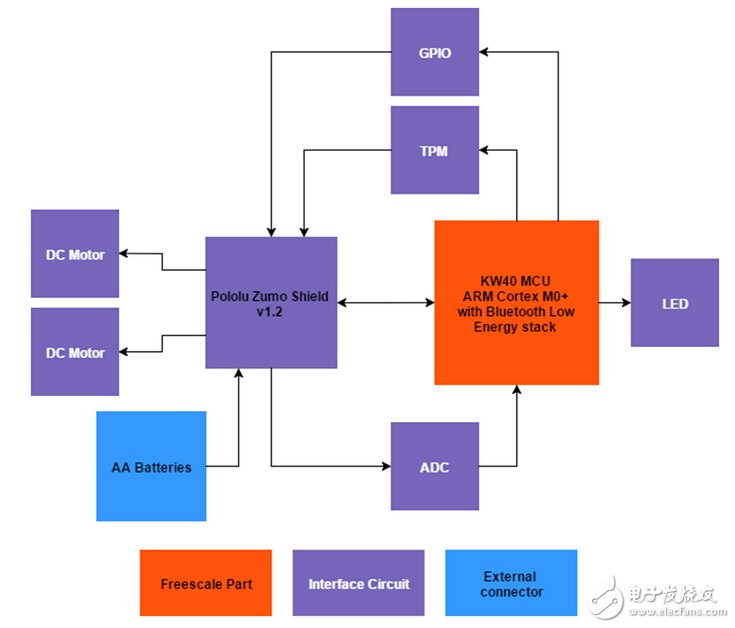
2, characteristics
These include NXP's ultra-low-power KineTIs KW40Z SoC, which provides Bluetooth® Smart/Bluetooth® Low Energy (BLE) v4.1 and/or IEEE® 802.15.4-2011 for portable, ultra-low power embedded systems. RF connection.
Developed with the KineTIs Software Development Kit (SDK), providing comprehensive software support for KineTIs MCUs, including a hardware abstraction layer (HAL), drivers for each MCU peripheral, connection stack, middleware, real-time operating system, and application examples. Designed to simplify and accelerate application development based on Kinetis microcontrollers.
3, supported devices
KW40Z: Kinetis® KW40Z-2.4 GHz dual mode: BLE and 802.15.4 wirelessly connected microcontroller (MCU) based on ARM® Cortex®-M0+ core
The KW40Z is a highly integrated, single-chip device that enables portable, ultra-low-power embedded systems with Bluetooth® Smart/Bluetooth® Low Energy (BLE) v4.1 and IEEE® 802.15.4-2011 RF connectivity. Applications include portable medical devices, wearable sports and fitness equipment, AV remote controls, computer keyboards and mice, game controllers, access control, security systems, smart energy and home networking.
The KW40Z MCU integrates a 2.4 GHz transceiver supporting multiple FSK/GFSK and O-QPSK modulations, an ARM® Cortex®-M0+ processor, 160 KB flash and 20 KB SRAM, BLE link layer hardware, 802.15.4 packets The processor, hardware security and peripherals are optimized to meet the requirements of the target application. The KW40Z has enough on-chip memory to run both the Bluetooth Low Energy stack and the IEEE 8021.5.4 MAC/PHY for multimode applications.
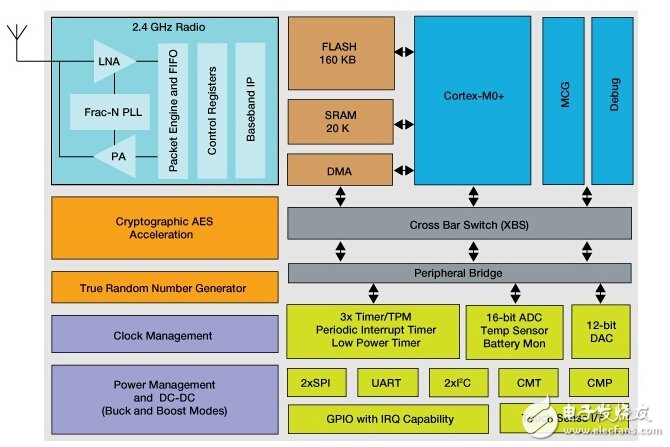
KW40Z structure block diagram
characteristic
Multi-protocol radio:
Compliant with 2.4 GHz Bluetooth Low Energy V4.1
Compliant with IEEE Std. 802.15.4-2011 standard
Typical Receive Sensitivity (BLE) = -91 dBm
Typical Receive Sensitivity (802.15.4) = -102 dBm
Transmit output power can be set from -20 dBm to +5 dBm
Kernel and memory aspects:
Up to 48 MHz ARM® Cortex-M0+ core
On-chip 160 KB flash
On-chip 20 KB SRAM
Low power consumption, operating voltage range:
9 low power modes, optimized power supply based on application requirements
Typical Receive/Transmit Current (DC/Support DC): 6.5 mA / 8.4 mA
Bypass voltage: 1.71V to 3.6V
DCDC converter step-down configuration: 2.1V to 4.2V
DCDC converter boost configuration: 0.9V to 1.795V
Analog module:
16-bit analog-to-digital converter (ADC)
12-bit digital-to-analog converter (DAC)
6-bit high speed analog comparator (CMP)
safety:
AES-128 Accelerator (AESA), True Random Number Generator (TRNG)
Support software:
BLE host protocol stack and configuration file, 802.15.4 MAC and SMAC
Kinetis® Software Development Kit (SDK)
FreeRTOS kernel and bare metal non-preemptive task scheduler
Second, Intel launched the E3800 series of industrial robot solutions
If you ask the main force of Industry 4.0, non-industrial robots are the only ones. Robots are used more and more widely. Even in many traditional industrial fields, people are trying to make robots work instead of humans. In the food and food production, the automobile manufacturing industry will become a trend in robot replacement. Food industry robots have been developed, including canned robots, automatic lunch robots, and cutting beef robots. Robots are used in food processing. China will become the world's largest robot market.
Intel solution overview:
The new Intel® AtomTM processor E3800 (formerly “Bay Trailâ€) features improved media/graphics performance, ECC, temperature range, comprehensive security, and integrated image processing. It can shorten the market investment time, improve the speed of integrated information application, reduce power consumption, etc., which satisfies the demand of industrial robots.
The system-on-a-chip (SoC) is based on the Silvermont microarchitecture and is manufactured using Intel's industry-leading 22nm process technology.
The E3800 Series SoCs deliver outstanding computing, graphics and media performance and operate in a wider range of thermal conditions.
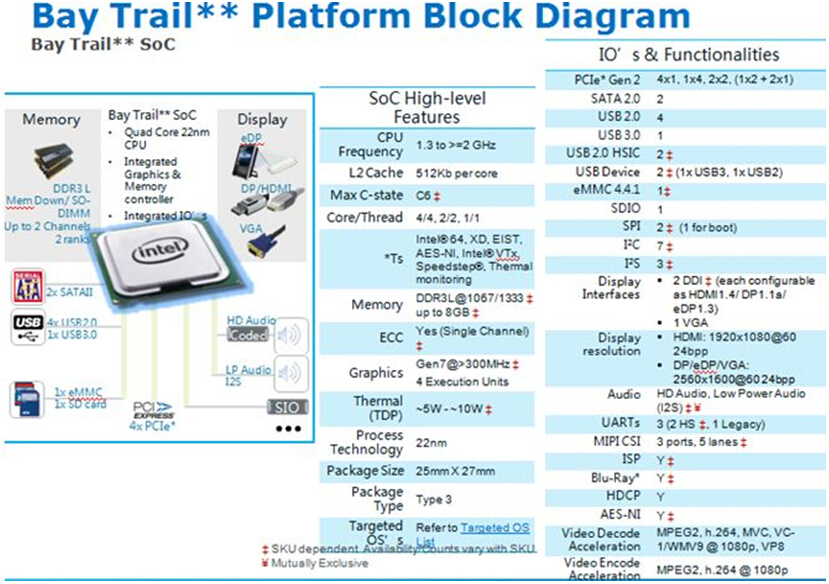
Program features:
22nm process technology.
Low power TDP5-10W for fanless design.
The main frequency is 1.3-2GHz, with 4 cores, dual cores and single core options.
Support ECC, only E3000 CPU supports ECC function to meet special industry needs.
Rich IO port to meet industry interface requirements.
Wide temperature design to support industrial special environmental work.
In short, in the current production area of ​​the processor, the baytrail E3000 series can meet the needs of special areas of work.
Third, intelligent interactive learning robot design
This program is a smart interactive learning robot, which is specially developed for the children's e-education market. It integrates communication, entertainment, learning and interaction. She can realize human-computer interaction through cloud speech recognition technology, and has accurate response to voice control commands such as encyclopedia query, interactive question and answer, weather query, calculation, translation, song on demand, and early education learning. She accurately identifies the natural language spoken by the user and responds to the user's question answer through the cloud computing server. She has a very good interactive experience. When the cloud server can't match the answer, she can achieve self-growth through self-learning and realize the initial artificial intelligence.
Scheme block diagram
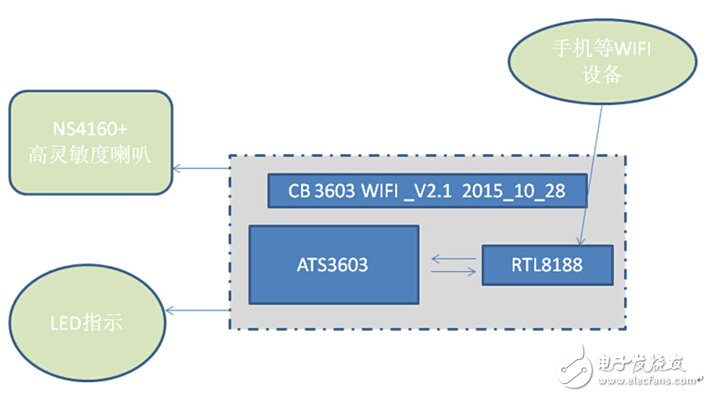
System functions
1, picture book learning voice interaction; 2, semantic recognition; 3, WeChat communication; 4, online on-demand; 5, information control; 6, local playback; 7, security mechanism; 8, WeChat group chat.
Program characteristics
NSIWAY audio dedicated chip NS4160.
Ultra low EMI, no filter required, maximum power up to 5W.
A three-color highlight LED is used to display the status of the operating content.
Use RealTek8188 WIFI module to increase product network link stability.
IV. Ruixin Micro Rockchip Robot Solution
“Ruiman Intelligent Robot†is a new man-machine dialogue service companion robot, mainly for home users.
1, the program overview
"Ruiman Intelligent Robot" uses RK3288 chip, equipped with super quad-core Cortex-A17, frequency up to 1.8GHz.
On the GPU side, the RK3288 is the world's first chip to adopt a new image engine technology. The addition of the top-of-the-line Mali-T764 GPU brings a variety of advanced technologies such as memory compression technology and global real-time light engine game technology.
The combination of the two makes the intelligent robot equipped with the RK3288 chip not only have more eye-catching functions, but also is very practical.
Rockchip RK3288 Features
The RK3288 combines multiple advantages. It is the world's first ARM new architecture core chip, the world's first chip of the latest Mali-T76x series GPU, and the world's first 4Kx2K hard-release H.265 video chip.
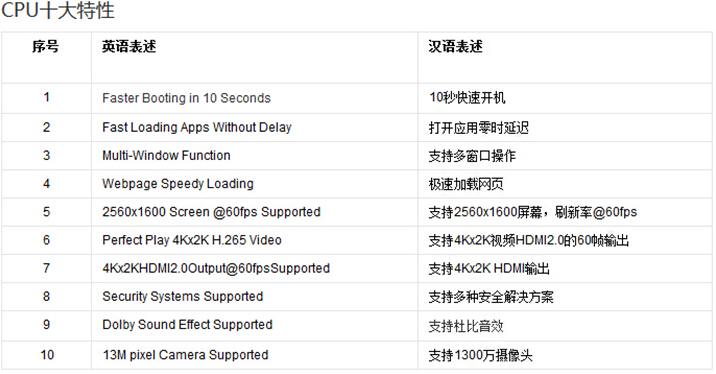

2, product features
The product can be connected wirelessly to the mobile phone, and can be easily manipulated with a finger movement. The 10.1-inch HD screen and camera are available for a variety of uses.
Direct voice dialogue, release hands, no touch screen control;
The leg has an obstacle avoidance function that automatically stops when it reaches the edge of the table;
When the battery is low, you can locate the power supply and automatically find the power supply.
The power of the RK3288 chip is reflected in this intelligent robot. (Comprehensive finishing)
Lithium Battery Cells,Lithium Ion Battery 12V,Lithium Polymer Battery 3.7V,Lithium Ion Battery 12V,China 18650 Battery,18650 Li Ion Battery Pack supplier & manufacturer, offer low price, high quality 10000Mah 18650 Battery Pack,18650 Lithium Battery Pack, etc.
The 18650 battery pack is one of the most popular lithium-ion battery packsavailable today.
Powered by the 18650 battery, it is very reliable and boasts an excellent cost per kilowatt hour. The 18650 battery pack is commonplace for consumer electronics, electric vehicles, and energy storage systems. It can be found in medical devices, robots, industrial instruments, military equipment, and more.
18650 Battery,18650 Li Ion Battery Pack,10000Mah 18650 Battery Pack,18650 Lithium Battery Pack
Shenzhen Glida Electronics Co., Ltd. , https://www.szglida.com
